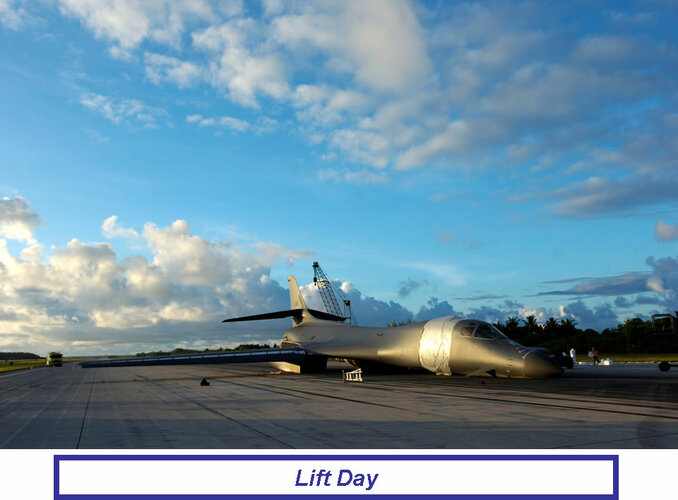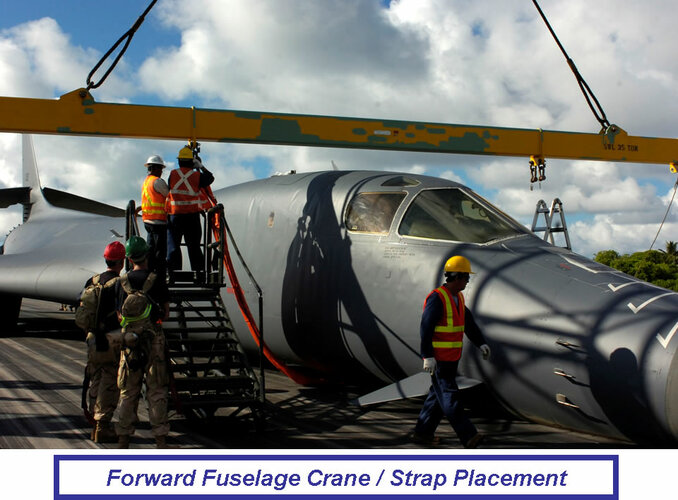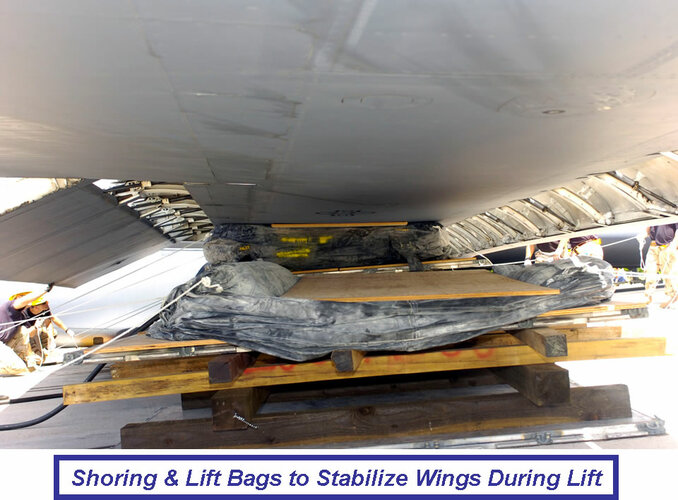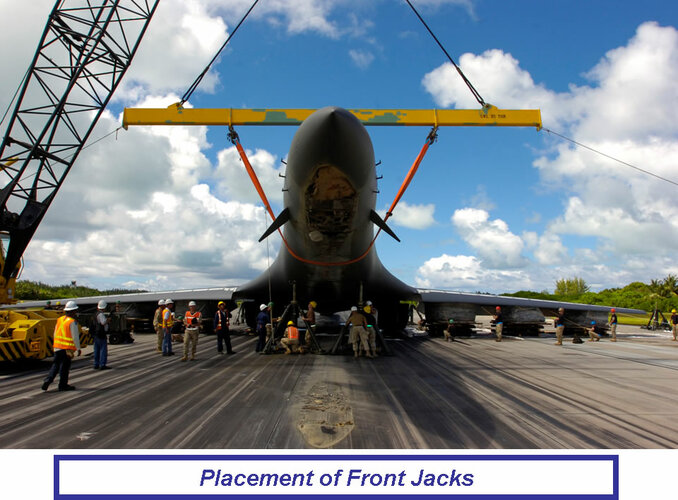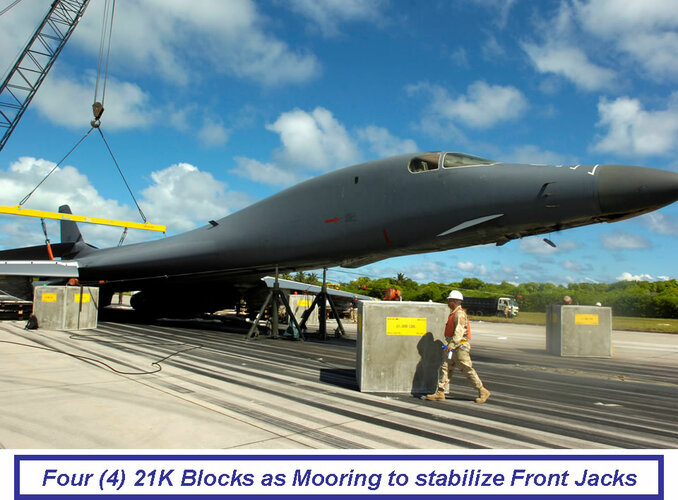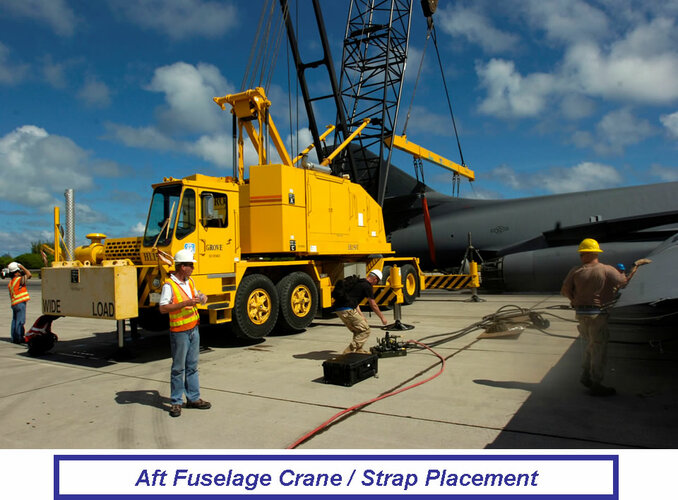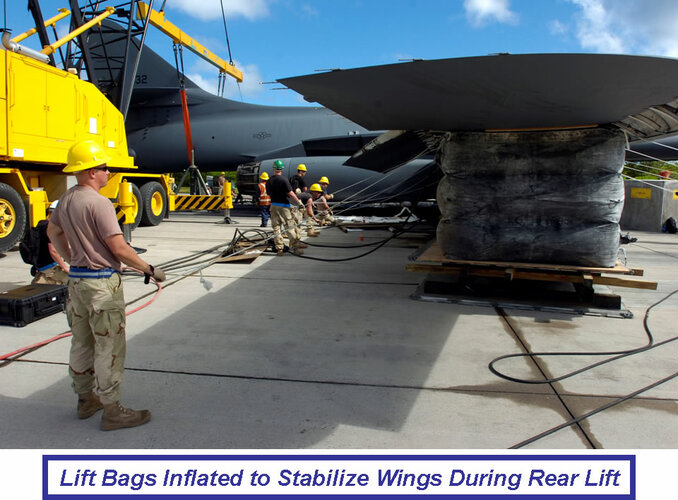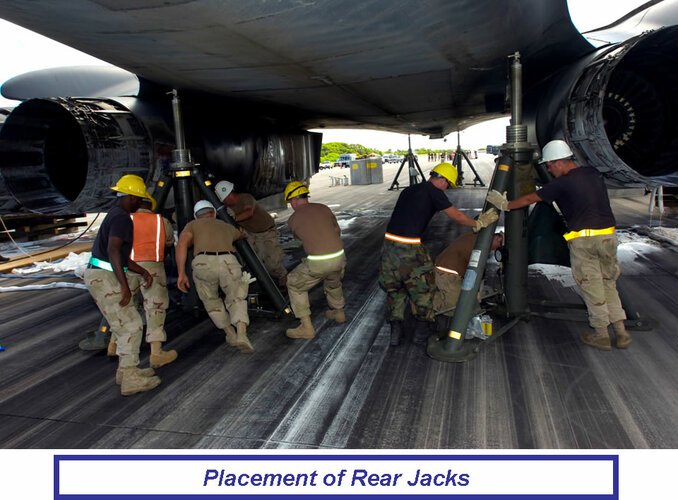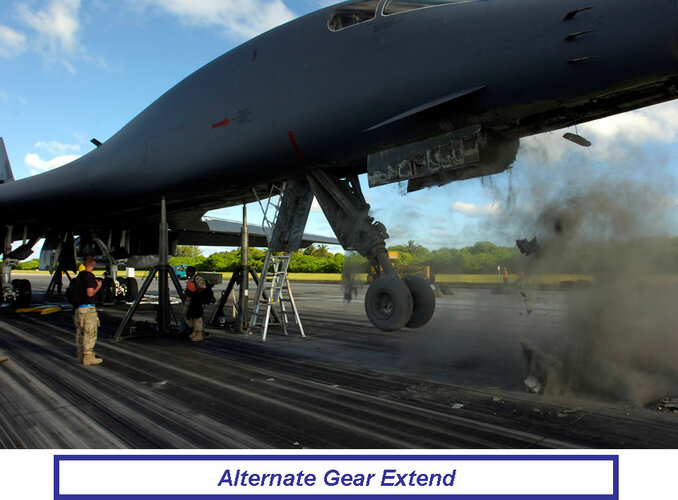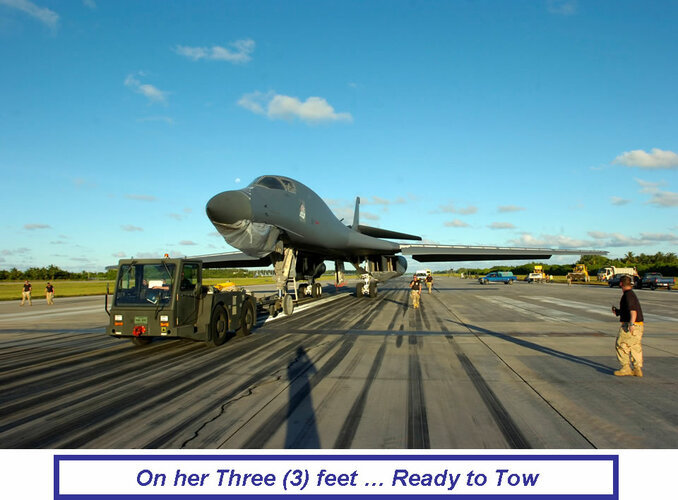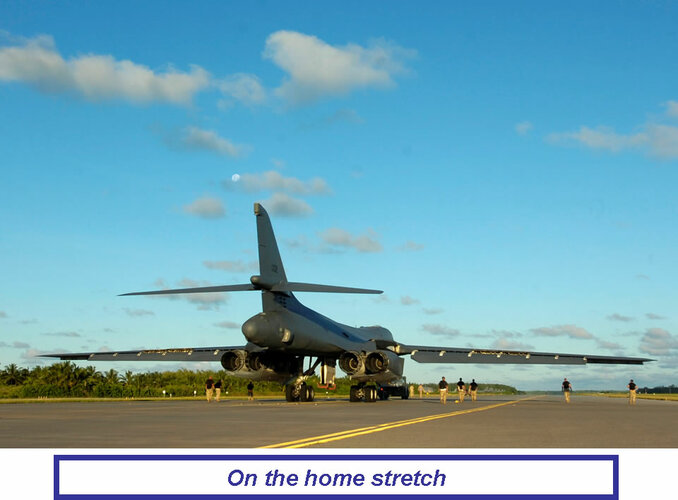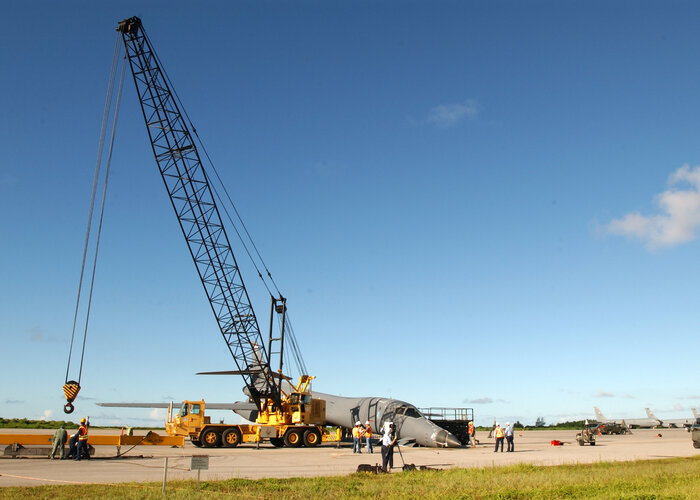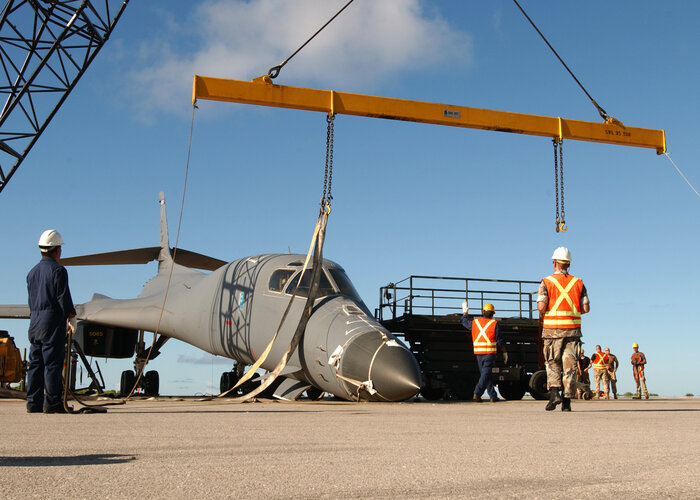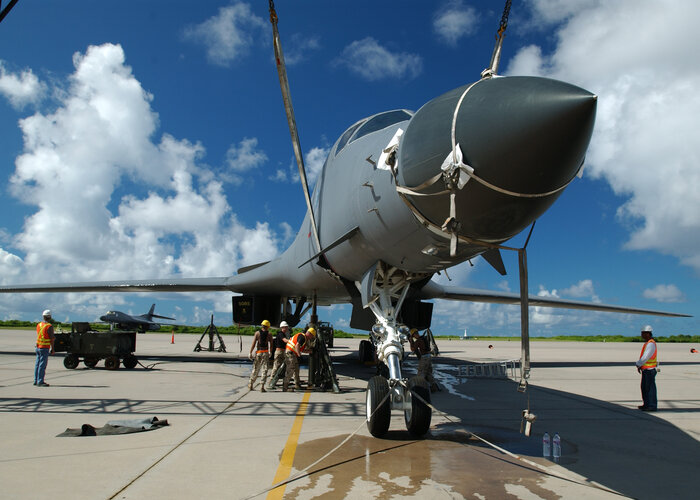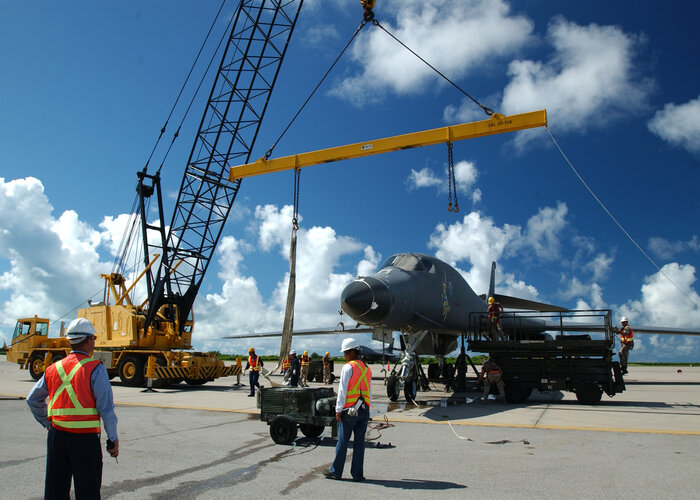You are using an out of date browser. It may not display this or other websites correctly.
You should upgrade or use an alternative browser.
You should upgrade or use an alternative browser.
USAF to Retire B-1, B-2 in Early 2030s as B-21 Comes On-Line
- Thread starter flateric
- Start date
As with anything aviation it's all about the design trades and requirements... Two aircraft designed to operate under much different conditions with one designed when jet aircraft were far better understood. A Bone all day everyday will out turn a BUFF down low, then again one is a 2G airframe the other is over 3G at certain weights and wings sweep angles. One loves to fly in the mid 30's the other pretty much only will get there on a supersonic transit before it slows down to drop it's bombs. Don't get me wrong TST in OIF/OEF saved the Bone, but nearly all their fatigue life got used up in the sand box. The BUFF has tons of life left because quite frankly it was over engineered and not rode nearly as hard as the one with nice curves.So to sum up:
B-1B vs B-52
Range advantage: B-52
Maneuverability advantage: B-52
RCS advantage: B-1B
Maximum bomb load advantage: B-1B
Speed advantage: B-1B
Cost advantage: B-52
Load was highly dependent on mission, yes the Bone can carry 24 GBU-31, but then again they got to takeoff a few thousand miles closer than the other (Thumrait vs. Diego). When the Bones flew from Diego the front bay was a tank and they only carried 16. The 12 on the BUFF were external and fatigued the GBU-31's (full disclosure I flew/conducted those test flights) but carried 27 Mk117's in the bay which tended to be pretty useful. But really, how often were 12, 16 or 24 GBU-31's used on any TST mission? Even max bomb load depends on the metric, are we measuring weight, number of weapons or overall destructiveness of the weapons carried? The BUFF can carry stores the Bone can only dream about carrying and then basing mission design mean a perceived advantage can/doesn't exist. Now that the BUFF carries 1760 in the bay which carries more from Diego/Anderson the BUFF or the Bone that has to upload a tank to the front bay?
Also, the Bone's RCS advantage was far overstated, but things like that and the EW suites tend to not like to be discussed in public.
When I showed up to Dyess AFB in Aug 2002 there was a real question mark over whether there would still be a 7th BW when my tour ended in 2005. TST, connect and the JDAM saved the Bone and were the right tool for 19 years of missions in the sandbox. Given the condition of the respective airframes and what complements a high altitude stealthy B-21, the old BUFF wins out. I've spent 8 years of my life working on both aircraft, knowing what I know and also getting to work a little bit with the B-2, the B-21 and BUFF are the right 2 aircraft mix for the future.
At the end of the day it comes down to this fly low to survive mindset. An aircraft designed to fly high can always fly low, maybe not quite as fast as an aircraft purpose built to fly low. But the reverse is not true the low guy can't fly high and can never add the wing area or extra thrust to fly high efficiently. The big lesson fortunately (I hope) learned on the B-21 is the stealth stuff works so don't waste your time on the low level stuff like the B-2 and add cost and time that kill your program and leave you with only 21 airframes.
Last edited:
FighterJock
ACCESS: Above Top Secret
- Joined
- 29 October 2007
- Messages
- 5,577
- Reaction score
- 5,896
One of the many B-52 follow on studies at Boeing included what was essentially a bigger B-52. Looked just like a B-52 but with four double engine nacelles under each wing.
Are there any pictures of said B-52 bomber follow on sferrin? How many bomb bays would there have been on the big B-52? Considering that there is only one bomb bay on the standard B-52.
Last edited by a moderator:
Pretty surprising, Encounter isn't a small publisher. His other well know book Clashes is also print only. The paper back prices are reasonable, although $900 for a new hardcover is steep.Mystified why that book you mentioned isn’t on Kindle as that’s usually the easiest and cheapest way to get older books. Shame because it looks well thought of.
Last edited:
Boeing Wichita did have a few models here and there of unbuilt BUFF's. Can't say I remember seeing anything like that, wish I did though...One of the many B-52 follow on studies at Boeing included what was essentially a bigger B-52. Looked just like a B-52 but with four double engine nacelles under each wing.
- Joined
- 16 April 2008
- Messages
- 9,586
- Reaction score
- 14,418
although $900 for a new hardcover is steep.
And it's very likely that the sellers offering it for that absurd amount don't actually own it. They've found one seller somewhere who has a copy for much less but hasn't listed it on Amazon. And now they've got a ridiculous race condition happening where each seller over-prices the last and we end up with $900 for a book that might, maybe, be worth a tenth that much.
Of course, got all excited at work because I did buy Clashes in hardback, frankly I almost always try to buy hardback. But alas, when I got home and looked at the bookshelf in the home office 11 Days is soft cover. Then again $50 for a hardcover was pretty steep for a 1 year O-3 in 2007, 2020 me is beating 2007 me with said soft cover for my poor foresightalthough $900 for a new hardcover is steep.
And it's very likely that the sellers offering it for that absurd amount don't actually own it. They've found one seller somewhere who has a copy for much less but hasn't listed it on Amazon. And now they've got a ridiculous race condition happening where each seller over-prices the last and we end up with $900 for a book that might, maybe, be worth a tenth that much.
Now the shameless attempt to make some reasonable attempt to tie another hopelessly off topic post back to the thread topic... The good book does say there's nothing new under the sun... One of the issues raised in 11 Days was the different EW suites between conventionally focused BUFF's and SAC focused BUFF's drove some differences around tactics. SAC was notoriously ridged and the plan was the plan was the plan... F-117 and B-2 notoriously flew the blue line so thou shall not be seen. Will we with the B-21 finally get a stealth bomber that can dynamically compute engagement/detection ranges and let the crew figure out dynamically how to defeat enemy defenses or even have offensive abilities to degrade the air defenses to improve the success?
Last edited:
- Joined
- 3 June 2011
- Messages
- 18,305
- Reaction score
- 12,130
All I've seen is a small line drawing in Jenkin's Valkyrie book.
Are there any pictures of said B-52 bomber follow on sferrin? How many bomb bays would there have been on the big B-52? Considering that there is only one bomb bay on the standard B-52.
232' span, 190' length:
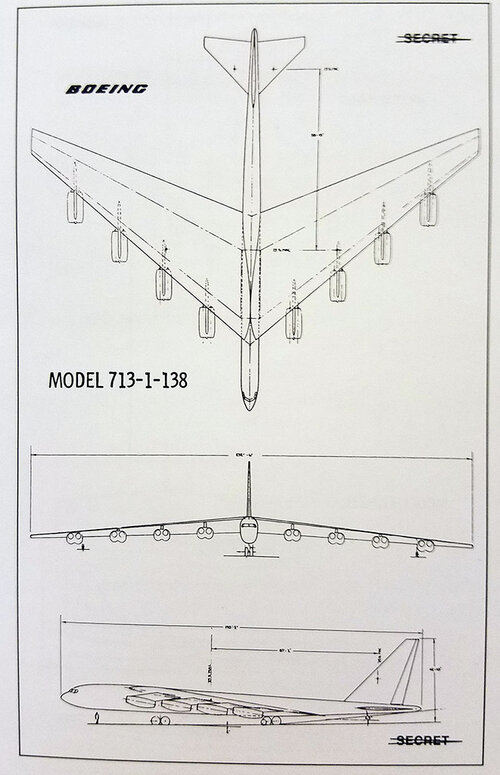
Amazon.com: Valkyrie: North American's Mach 3 Superbomber (0619051000725): Jenkins, Dennis R., Landis, Tony R., White, Alvin S., Fulton Jr., Fitzhugh L.: Books
Amazon.com: Valkyrie: North American's Mach 3 Superbomber (0619051000725): Jenkins, Dennis R., Landis, Tony R., White, Alvin S., Fulton Jr., Fitzhugh L.: Books
www.amazon.com
Last edited by a moderator:
FighterJock
ACCESS: Above Top Secret
- Joined
- 29 October 2007
- Messages
- 5,577
- Reaction score
- 5,896
Thanks for posting the diagram sferrin.
- Joined
- 24 January 2006
- Messages
- 1,321
- Reaction score
- 466
Can either of them really maneuver to evade SAM?
Try making a turn in the Bone above 30kft with any type of load, oh wait it can't without losing altitude or airspeed. I've been in a BUFF practicing SAM evasions over the UTTR above 30kft, hint it can turn, maintain altitude and airspeed
You often don't necessarily need to defeat the missile, but rather the engagement radar of the SAM. If you can sneak into the doppler notch you may be able to deny a target lock or break track and screw up midcourse guidance.
Simply reversing course could throw off a missile pretty wildly if you are at the edge of its envelope or if it has no ability to receive mid course updates, or if it has to commit to a first stage booster burn out before it adjusts it's trajectory. Depends on the SAM type and engagement geometry, but any change of velocity post SAM launch would be preferable to maintaining course and speed into the projected intercept point.
- Joined
- 24 January 2006
- Messages
- 1,321
- Reaction score
- 466
Simply reversing course could throw off a missile pretty wildly if you are at the edge of its envelope or if it has no ability to receive mid course updates, or if it has to commit to a first stage booster burn out before it adjusts it's trajectory. Depends on the SAM type and engagement geometry, but any change of velocity post SAM launch would be preferable to maintaining course and speed into the projected intercept point.
You don't even necessarily need to reverse course. Any sort of maneuvering that makes a missile change its flightpath after burnout is making the missile burn kE. Oversimplified, but think of kE as what it converts into range or maneuvering ability. If a SAM burns all its kE making midcourse corrections it's left with very little to use maneuvering at endgame. You may still be SOL in a cooperative target like a BUFF or JSTARS or something else large and slow.
Of course, most missiles are fast, some of them (48N6, 9M82, etc.) are REALLY fast at burnout, so they have enough kE to play with regardless in most cases. Then you add a directional warhead of enormous size and avoiding one that actually manages to track in on you to endgame...well, you're basically left hoping the proximity fuze was built by someone having an off day.
Toss in a fair amount of EW, expendables things get really interesting. It was prof for the EWO and the view from the gunner seat was pretty good.Can either of them really maneuver to evade SAM?
Try making a turn in the Bone above 30kft with any type of load, oh wait it can't without losing altitude or airspeed. I've been in a BUFF practicing SAM evasions over the UTTR above 30kft, hint it can turn, maintain altitude and airspeed
You often don't necessarily need to defeat the missile, but rather the engagement radar of the SAM. If you can sneak into the doppler notch you may be able to deny a target lock or break track and screw up midcourse guidance.
- Joined
- 3 June 2011
- Messages
- 18,305
- Reaction score
- 12,130
Get one of these to set off a 30mm HEI round on the Tombstone though. . .Simply reversing course could throw off a missile pretty wildly if you are at the edge of its envelope or if it has no ability to receive mid course updates, or if it has to commit to a first stage booster burn out before it adjusts it's trajectory. Depends on the SAM type and engagement geometry, but any change of velocity post SAM launch would be preferable to maintaining course and speed into the projected intercept point.
You don't even necessarily need to reverse course. Any sort of maneuvering that makes a missile change its flightpath after burnout is making the missile burn kE. Oversimplified, but think of kE as what it converts into range or maneuvering ability. If a SAM burns all its kE making midcourse corrections it's left with very little to use maneuvering at endgame. You may still be SOL in a cooperative target like a BUFF or JSTARS or something else large and slow.
Of course, most missiles are fast, some of them (48N6, 9M82, etc.) are REALLY fast at burnout, so they have enough kE to play with regardless in most cases. Then you add a directional warhead of enormous size and avoiding one that actually manages to track in on you to endgame...well, you're basically left hoping the proximity fuze was built by someone having an off day.
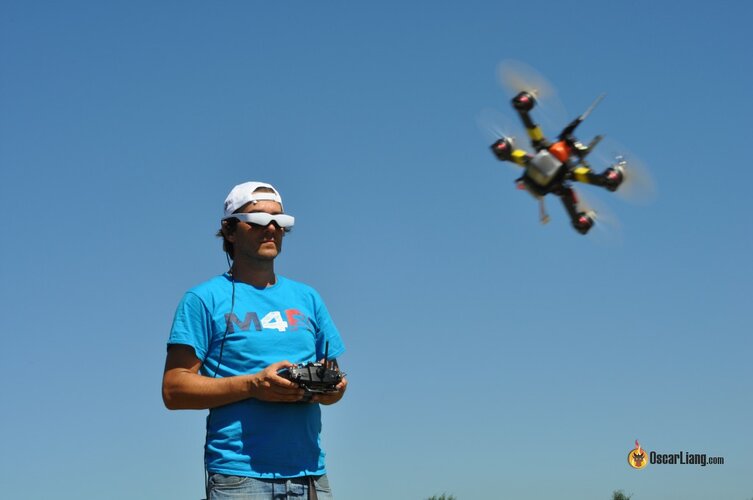
- Joined
- 18 June 2009
- Messages
- 1,412
- Reaction score
- 2,493
Log into Facebook
Log into Facebook to start sharing and connecting with your friends, family, and people you know.
 www.facebook.com
www.facebook.com
Attachments
- Joined
- 19 July 2016
- Messages
- 4,260
- Reaction score
- 3,443
I take it that repairs cost a bit more than 50 pence and a half chewed bubble gum though.
Yes, the crew who forgot to lower the gear on approach after the long ferry flight from DY to Diego. Wasn't the first time the 7 EMS guys barrowed the Navy crane for a lift. About 18 months, 2 years earlier my AR troops lifted the EL can bird that IFE'd on departure, when the just got back into the chocks and the engines shut down the nose gear collapsed as the crew chief was climbing up to pin the gear. He jumped out of the way, narrowly avoiding being crushed.That's a blast from the past. There was an article about it back in '06:
Have the pictures of that lift in one of my boxes of old AF stuff. Have to be careful going through that stuff, the better half might start getting ideas about throwing out old junk to "organize"...
Last edited:
Not really, while it cost $7-8M to repair, the accident was actually quite gentle for a gear up. A lot of that cost was the radar altimeter, which is right there under the nose.What I found amazing was that it was actually returned to service, from what I remember.
Now, the landing Col B. made when he was a younger pilot with the nose gear up, you can actually see the backbone of the jet flex when he put it down. Which is also to say the ABDR crews at Tinker have repaired that type of damage in the past.
- Joined
- 3 June 2011
- Messages
- 18,305
- Reaction score
- 12,130
That the one at Edwards?Not really, while it cost $7-8M to repair, the accident was actually quite gentle for a gear up. A lot of that cost was the radar altimeter, which is right there under the nose.What I found amazing was that it was actually returned to service, from what I remember.
Now, the landing Col B. made when he was a younger pilot with the nose gear up, you can actually see the backbone of the jet flex when he put it down. Which is also to say the ABDR crews at Tinker have repaired that type of damage in the past.
Yes, it landed at ED, but took off from DY if my memory is correct. Capt. B was flying a local mission, nose gear didn't come down. He had enough gas to make it to ED so they (wing leadership and crew) elected to put it down on the lake bed. It also gave them some time to call the engineers and talk things over, get a warm fuzzy before letting him attempt the landing.That the one at Edwards?Not really, while it cost $7-8M to repair, the accident was actually quite gentle for a gear up. A lot of that cost was the radar altimeter, which is right there under the nose.What I found amazing was that it was actually returned to service, from what I remember.
Now, the landing Col B. made when he was a younger pilot with the nose gear up, you can actually see the backbone of the jet flex when he put it down. Which is also to say the ABDR crews at Tinker have repaired that type of damage in the past.
Update:
Here's a link to an article and video of the event:
https://www.avgeekery.com/day-b-1-bones-nose-gear-wouldnt-extend/
Last edited:
There were at least two wing swept back that I'm aware of, one was in Germany the other in CONUS. Memory's dim because I didn't know any of the crew from either.Okay. I was thinking of the one with the wings stuck in a swept position, landed at high speed, and the nose gear collapsed.
Not, sure about the nose gear collapsing, but in at least one of the cases the mains blew, broke the hydraulic lines to the brakes and the fluid caught fire on the the hot brakes.
- Joined
- 3 June 2011
- Messages
- 18,305
- Reaction score
- 12,130
Hmmm. Only pics of a lake bed landing I can find are from the incident you mentioned. (The wings are obviously forward.)There were at least two wing swept back that I'm aware of, one was in Germany the other in CONUS. Memory's dim because I didn't know any of the crew from either.Okay. I was thinking of the one with the wings stuck in a swept position, landed at high speed, and the nose gear collapsed.
Not, sure about the nose gear collapsing, but in at least one of the cases the mains blew, broke the hydraulic lines to the brakes and the fluid caught fire on the the hot brakes.
That's the video of Capt. B.Hmmm. Only pics of a lake bed landing I can find are from the incident you mentioned. (The wings are obviously forward.)There were at least two wing swept back that I'm aware of, one was in Germany the other in CONUS. Memory's dim because I didn't know any of the crew from either.Okay. I was thinking of the one with the wings stuck in a swept position, landed at high speed, and the nose gear collapsed.
Not, sure about the nose gear collapsing, but in at least one of the cases the mains blew, broke the hydraulic lines to the brakes and the fluid caught fire on the the hot brakes.
Everyone's seen the pictures of the Bone with the main's on fire that landed wings swept back, no nose gear collapse there. Pretty sure that there was one other wing swept landing, don't recall seeing any pictures, don't recall if the nose gear collapsed or if the mains caught fire on that one. Wouldn't surprise me if that one was at ED as the longest lakebed runway is 30,000 ft long.
Here's the video of the ED landing on runway 04, there was a brake fire.Hmmm. Only pics of a lake bed landing I can find are from the incident you mentioned. (The wings are obviously forward.)There were at least two wing swept back that I'm aware of, one was in Germany the other in CONUS. Memory's dim because I didn't know any of the crew from either.Okay. I was thinking of the one with the wings stuck in a swept position, landed at high speed, and the nose gear collapsed.
Not, sure about the nose gear collapsing, but in at least one of the cases the mains blew, broke the hydraulic lines to the brakes and the fluid caught fire on the the hot brakes.
Here's the link to the one that landed in Rhein-Main AB. Picture is on the Aviationist, credit is Wiki
https://i2.wp.com/theaviationist.com/wp-content/uploads/2020/07/B1_fire.jpg?ssl=1
Last edited:
- Joined
- 21 April 2009
- Messages
- 13,732
- Reaction score
- 7,617

The B-1B just launched a cruise missile externally. Hypersonic missiles could be next.
If the Air Force decides to configure the B-1B to carry weapons externally, two B-1s will be able to carry the firepower equivalent to three B-1s today.
FighterJock
ACCESS: Above Top Secret
- Joined
- 29 October 2007
- Messages
- 5,577
- Reaction score
- 5,896

The B-1B just launched a cruise missile externally. Hypersonic missiles could be next.
If the Air Force decides to configure the B-1B to carry weapons externally, two B-1s will be able to carry the firepower equivalent to three B-1s today.www.defensenews.com
Interesting news bobbymike, before this article I had previously thought that launching cruise missiles was totally impossible from the external hard points on the B-1B, since I thought that all the necessary wiring was removed at the end of the Cold War and after the 1991 Desert Storm. Looks like we will be seeing the carrying of Hypersonic missiles on the external hard points as soon as they become available.
I think it was discussed earlier in this thread; a number of B-1s have had a single pylon on the front right wired to use targeting pods, so for this one hard point is wired in some cases. Additionally I believe this is actually a test aircraft that probably has additional wiring to this position. It would require a pretty expensive program to wire all the hard points for MIL-STD-1760.
FighterJock
ACCESS: Above Top Secret
- Joined
- 29 October 2007
- Messages
- 5,577
- Reaction score
- 5,896
I think it was discussed earlier in this thread; a number of B-1s have had a single pylon on the front right wired to use targeting pods, so for this one hard point is wired in some cases. Additionally I believe this is actually a test aircraft that probably has additional wiring to this position. It would require a pretty expensive program to wire all the hard points for MIL-STD-1760.
I had known about the B-1B getting targeting pods for the targeting and dropping of laser and satellite guide bombs for a while, but this is a first for me when it comes to dropping a JASSM missile from the external pylon. Though I wonder how long it would take to re-wire all the hard points for all the B-1B's that currently remain in service.
I think it was brought up in another thread, but there are only eleven examples who have the possibility of being put back into service, and that assumes the bone yard hasn't stripped them to keep the current fleet. It's a great plane, but it isn't something you can make more of.76 BUFFs, how about at least 100. 95 was low enough, jeepers. and low altitude infiltration (forward canards a etc)
The wiring was never there, and the black boxes for ALCM were never installed. After OEF/OIF when Bones had to with hold dropping with troops in contact, due to lack of visual ID, Sniper was rushed through. That's when the front right pylon got wired the Russian's agreed not to call it a treaty violation and the rest is history.
The B-1B just launched a cruise missile externally. Hypersonic missiles could be next.
If the Air Force decides to configure the B-1B to carry weapons externally, two B-1s will be able to carry the firepower equivalent to three B-1s today.www.defensenews.com
Interesting news bobbymike, before this article I had previously thought that launching cruise missiles was totally impossible from the external hard points on the B-1B, since I thought that all the necessary wiring was removed at the end of the Cold War and after the 1991 Desert Storm. Looks like we will be seeing the carrying of Hypersonic missiles on the external hard points as soon as they become available.
Memory fades after all these years, can't quite remember if Sniper uses 1760 or not, but for the sake of argument let's assume that it does. I also stands to reason they took an off the shelf 30 in rack and put it in the pylon. When the pod was carried it was pinned, safety wired and no carts installed. If there's 1760, a functional rack all that's left is Seek Eagle approval that the store will come off safely. They must have felt pretty good about it going straight to a launch and not a safe store jettison.I think it was discussed earlier in this thread; a number of B-1s have had a single pylon on the front right wired to use targeting pods, so for this one hard point is wired in some cases. Additionally I believe this is actually a test aircraft that probably has additional wiring to this position. It would require a pretty expensive program to wire all the hard points for MIL-STD-1760.
I had known about the B-1B getting targeting pods for the targeting and dropping of laser and satellite guide bombs for a while, but this is a first for me when it comes to dropping a JASSM missile from the external pylon. Though I wonder how long it would take to re-wire all the hard points for all the B-1B's that currently remain in service.
Last edited:




